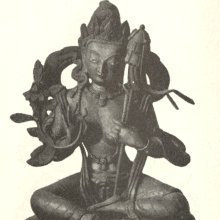Parishkaravashita, Pariṣkāravaśitā, Parishkara-vashita: 3 definitions
Introduction:
Parishkaravashita means something in Buddhism, Pali. If you want to know the exact meaning, history, etymology or English translation of this term then check out the descriptions on this page. Add your comment or reference to a book if you want to contribute to this summary article.
The Sanskrit term Pariṣkāravaśitā can be transliterated into English as Pariskaravasita or Parishkaravashita, using the IAST transliteration scheme (?).
Images (photo gallery)
In Buddhism
Tibetan Buddhism (Vajrayana or tantric Buddhism)
Source: archive.org: The Indian Buddhist IconographyPariṣkāravaśita (परिष्कारवशित) refers to one of twelve Vaśitā Goddesses, as commonly depicted in Buddhist Iconography, and mentioned in the 11th-century Niṣpannayogāvalī of Mahāpaṇḍita Abhayākara.—Her Colour is yellow; her Symbol is a cintāmaṇi; she has two arms.
Pariṣkāravaśita is described in the Niṣpannayogāvalī (dharmadhātuvāgīśvara-maṇḍala) as follows:—
“Pariṣkāravaśita is yellow in colour and holds in her left hand the cintāmaṇi banner”.
[These Vaśitās are collectively taken to be the spiritual daughters of the Dhyāni Buddha Amitābha. The twelve Vaśitā Goddesses [viz., Pariṣkāravaśita] are described collectively as two-armed, holding in their right hands the lotus and in the left proudly bearing their special symbols.]

Tibetan Buddhism includes schools such as Nyingma, Kadampa, Kagyu and Gelug. Their primary canon of literature is divided in two broad categories: The Kangyur, which consists of Buddha’s words, and the Tengyur, which includes commentaries from various sources. Esotericism and tantra techniques (vajrayāna) are collected indepently.
Mahayana (major branch of Buddhism)
Source: Wisdom Library: Maha Prajnaparamita SastraPariṣkāravaśitā (परिष्कारवशिता) refers to “(having) mastery over wealth”, according to Mahāprajñāpāramitāśāstra (chapter 4).—Accordingly, “[Question: Why is the Buddha called Bhagavat?]—[Answer]: [...] Furthermore, bhāga means glory (yaśas-) and vat indicates its possession. [...] The noble Cakravartin kings often reign over the four continents (caturdvīpaka); the Buddha reigns over countless universes (apramāṇalokadhātu).—The Cakravartin kings have mastery over wealth (pariṣkāravaśitā); the Buddha has mastery over mind (cetovāśita).—The noble Cakravartin kings covet heavenly bliss (devasukha); the Buddha covets nothing, having reached the well-being of the summit of existence (bhavāgrasukha). [...]”.

Mahayana (महायान, mahāyāna) is a major branch of Buddhism focusing on the path of a Bodhisattva (spiritual aspirants/ enlightened beings). Extant literature is vast and primarely composed in the Sanskrit language. There are many sūtras of which some of the earliest are the various Prajñāpāramitā sūtras.
General definition (in Buddhism)
Source: Wisdom Library: Dharma-samgrahaPariṣkāravaśitā (परिष्कारवशिता) or simply Pariṣkāra refers to the “mastery of discipline” and represents one of the “ten masteries of the Bodhisattvas” (vaśitā) as defined in the Dharma-saṃgraha (section 74). The Dharma-samgraha (Dharmasangraha) is an extensive glossary of Buddhist technical terms in Sanskrit (e.g., pariṣkāra-vaśitā). The work is attributed to Nagarguna who lived around the 2nd century A.D.
See also (Relevant definitions)
Partial matches: Vasita, Parishkara.
Full-text: Parishkara, Vasita, Ten Masteries, Cetas, Devasukha, Bhavagra, Cetovashita.
Relevant text
Search found 1 books and stories containing Parishkaravashita, Pariṣkāravaśitā, Parishkara-vashita, Pariṣkāra-vaśitā, Pariskaravasita, Pariskara-vasita; (plurals include: Parishkaravashitas, Pariṣkāravaśitās, vashitas, vaśitās, Pariskaravasitas, vasitas). You can also click to the full overview containing English textual excerpts. Below are direct links for the most relevant articles:
Maha Prajnaparamita Sastra (by Gelongma Karma Migme Chödrön)
Part 1 - Why is the Buddha called Bhagavat < [Chapter IV - Explanation of the Word Bhagavat]

